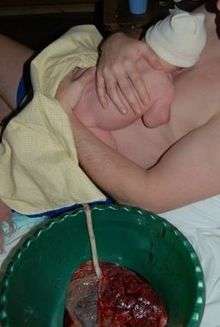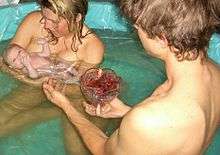Lotus birth
Lotus birth (or umbilical cord nonseverance - UCNS) is the practice of leaving the umbilical cord uncut after childbirth so that the baby is left attached to the placenta until the cord naturally separates at the umbilicus.[1] This usually occurs within 3–10 days after birth.[2] The practice is performed mainly for spiritual purposes of the parents, including for the perceived spiritual connection between placenta and newborn.[3]

No evidence exists to support any medical benefits for the baby.[4] The Royal College of Obstetricians and Gynaecologists has warned about the risks of infection[4] as the decomposing placenta tissue becomes a nest for infectious bacteria such as Staphylococcus. In one such case a 20-hour old baby whose parents chose the ritual of UCNS was brought to hospital in agonal state, was diagnosed with sepsis and required 6-weeks long antibiotic treatment.[5][6]
History
Although recently arisen as an alternative birth phenomenon in the West, super-delayed (1+ hours post-birth) umbilical severance is common in home births. Umbilical nonseverance has been recorded in a number of cultures including that of the Balinese [7] and of some aboriginal peoples such as the !Kung.
Early American pioneers, in written diaries and letters, reported practicing nonseverance of the umbilicus as a preventative measure, as they believed it protected the infant from an open wound infection.[8]
Modern practice

In the 1980s, yoga practitioners brought the idea to the United States and Australia, with the "lotus birth moniker, creating a link between the preciousness of the placenta and the high esteem in which the lotus is held in the Hindu and Buddhist faiths".[9] Yoga master and midwife Jeannine Parvati Baker being the main advocate for the practice in the United States.[2]
The practice spread to Australia by a midwife, Shivam Rachana, founder of the International College of Spiritual Midwifery and author of the book Lotus Birth.[10]
In the full lotus birth clinical protocol, the umbilical cord, which is attached to the baby's navel and placenta, is not clamped nor cut. The baby is immediately placed on the mother's belly/chest (depending on the length of the cord) or kept in close proximity to the mother in cases when medically necessary procedures such as resuscitation may be needed. Lotus birth, after the placenta is born vaginally (often with the maternal informed choice for passive management of third stage allowing for natural detachment of the placenta within appropriate time allowed for it, with no hormonal injections such as oxytocin) or via cesarean section.[11]
Following birth, the placenta is simply put in a bowl or quickly wrapped in absorbent toweling and placed near the mother-baby. Caregivers step back to allow for undisturbed maternal-child bonding to occur as the primary event for an hour or more. It is only after this initial intense bonding period that the placenta is managed by rinsing, drying, applying preservatives, and positioning it in a way that allows for plentiful air circulation and proximity to the baby. Organs that are separated from their blood supply begin to rot within minutes, and the placenta is prone to infection.[12] Over time, the cord dries and detaches from the baby's belly. This generally occurs 3–10 days postpartum.[13][2] This practice requires the mother and baby to be home bound as they wait for the decomposing flesh of the placenta and umbilical cord to dry and separate from the baby.[14]
Spiritual

Relation to nature
Significantly delayed cord cutting as well as nonseverance is found in birth anthropology along with the universality of reverence for the cord & placenta (as found in the Tree of Life beliefs of tribal cultures around the world—reported by scholar & professor Joseph Campbell).
In the animal world, placenta is usually consumed by mother. e.g. placentophagy. There are observations that primates are keeping placenta attached to their newborns for longer period. Primatologist Jane Goodall, who was the first person to conduct long-term studies of chimpanzees in the wild, reported that they did not chew or cut their offspring's cords, instead leaving the umbilicus intact, like many other monkeys.[15] Other researchers report[16], that chimpanzees consume placentas after birth. Though other mammals may sever their offspring's cords, they only do so after initial maternal sensory reception, unwinding of the cord, massage/cleaning (through touch), and initiation of nursing. [17] This has been observed to involve at least one hour, if left undisturbed.
Energy
Pseudo-scientific proponents of lotus births view the baby and the placenta as one on a cellular level, as they are from the same source, the egg and sperm conceptus. They also assert that the newborn and the placenta exist within the same quantum field, thus influencing various expressions of quantum mechanics that influence health.[18] They claim transfers of energy & cellular information continue to take place, moving gradually from the tissue of the placenta to the baby during the drying process. Scientists challenge this claim of a metaphysical dimension related to quantum mechanics.[19]
Medicine

Lotus births are an extremely rare practice in hospitals.[3]
Risks
Pat O'Brien, Royal College of Obstetricians and Gynaecologists[9]
The Royal College of Obstetricians and Gynaecologists (RCOG) has stated, "If left for a period of time after the birth, there is a risk of infection in the placenta which can consequently spread to the baby. The placenta is particularly prone to infection as it contains blood. At the post-delivery stage, it has no circulation and is essentially dead tissue," and the RCOG strongly recommends that any baby that undergoes lotus birthing be monitored closely for infection.[4]
Other risks include Jaundice caused by abnormally high bilirubin and Polycythemia, which is an abnormally high percentage of red blood cells in circulation [20]
Currently, there are no statistics which show how many woman choose lotus birth. Case descriptions about adverse medical conditions related to this praxis are emerging, indicating severity of potential complications [21][22]
References
- 1955-, Walsh, Denis (2007-01-01). Evidence-based care for normal labour and birth : a guide for midwives. Routledge. ISBN 978-0415418904. OCLC 156908214.
- Bindley, Katherine (12 April 2013). "Lotus Birth: Does Not Cutting The Umbilical Cord Benefit Baby?". Huffington Post. Retrieved 22 March 2017.
- Burns, Emily (Winter 2014). "More Than Clinical Waste? Placenta Rituals Among Australian Home-Birthing Women". The Journal of Perinatal Education. 23 (1): 41–49. doi:10.1891/1058-1243.23.1.41. PMC 3894590. PMID 24453467.
- "RCOG statement on umbilical non-severance or "lotus birth"". Royal College of Obstetricians and Gynaecologists. Retrieved 2017-02-09.
- Ittleman, Benjamin R.; German, Kendell R.; Scott, Emily; Walker, Valencia; Flaherman, Valerie J.; Szabo, Joanne; Beavers, Jessica B. (2019). "SAGE Journals: Your gateway to world-class journal research". Clinical Pediatrics. 58 (2): 238–240. doi:10.1177/0009922818805243. PMID 30280596.
- MD, Amy Tuteur (2018-12-19). "Lotus birth leaves a newborn critically ill with a heart infection". The Skeptical OB. Retrieved 2018-12-20.
- see Eat, Pray, Love by Elizabeth Gilbert, pp. 252-252
- Leavitt, Judith Walzer. Brought to Bed: Childbearing in America, 1750 to 1950. New York: Oxford University Press, 1986 pp.21-37
- Carroll, Helen (3 October 2013). "Is this the craziest (and most reckless) birthing fad EVER?: In lotus birthing, babies can be left with their placenta attached for TEN days... and doctors are horrified". Daily Mail.
- Hansen, Jane (23 June 2013). "Risky new trend of lotus birth". The Sunday Telegraph.
- stats
- Gunter, Jennifer (2017-08-30). "A lotus birth is leaving a newborn attached to a decomposing placenta". Retrieved 23 April 2018.
- Integral Life Practice: A 21st-Century Blueprint for Physical Health, Emotional Balance, Mental Clarity, and Spiritual Awakening. Wilber, Patton, Leonard, Morelli. Integral Books, 2008. ISBN 1590304675
- Senapathy, Kavin (2018-04-13). "Lotus Birth". Skeptical Inquirer. Retrieved 23 April 2018.
- See In the Shadow of Man by Jane Goodall.
- Fujisawa, Michiko, et al. "Placentophagy in wild chimpanzees (Pan troglodytes verus) at Bossou, Guinea." Primates 57.2 (2016): 175-180.
- Human Birth: An Evolutionary Perspective. Wenda Trevathan PhD, Univ of New Mexico Press, 2011. ISBN 1412815029
- The New Physics of Healing lecture, Harvard Medical School, Deepak Chopra MD, Cambridge, MA ISBN 156455919X , Audio recording.
- Stenger, Victor (January 1997). "Quantum Quackery". Skeptical Inquirer. Retrieved 23 April 2018.
- "Lotus births are trending….and they're probably a terrible idea". Pure Wow. Retrieved 23 April 2018.
-
- Ittleman, Benjamin R., et al. “Umbilical Cord Nonseverance and Adverse Neonatal Outcomes.” Clinical pediatrics (2018): 0009922818805243
- Tricarico, Antonella, et al. "Lotus birth associated with idiopathic neonatal hepatitis." Pediatrics & Neonatology 58.3 (2017): 281-282.
Further reading
- Buckley MD., Sarah. Gentle Birth, Gentle Mothering, Australia, 2006
- Davies RN, Leap RN, McDonald. Examination of the Newborn & Neonatal Health: A Multidimensional Approach, Elsevier Health Sciences, 2008. ISBN 0-443-10339-9
- Lim CPM, Robin. After the Baby's Birth: A Complete Guide for Postpartum Women, Ten Speed Press, U.S. 2001
- Parvati Baker, Jeannine. Prenatal Yoga & Natural Childbirth, North Atlantic Books, U.S., 2001
- Trevathan, Wenda. Human Birth: An Evolutionary Perspective, Univ. of New Mexico Press, 2011
- World Health Organization (WHO). Care in normal birth: A practical guide, report of a technical working group, Geneva, Switzerland, 1997